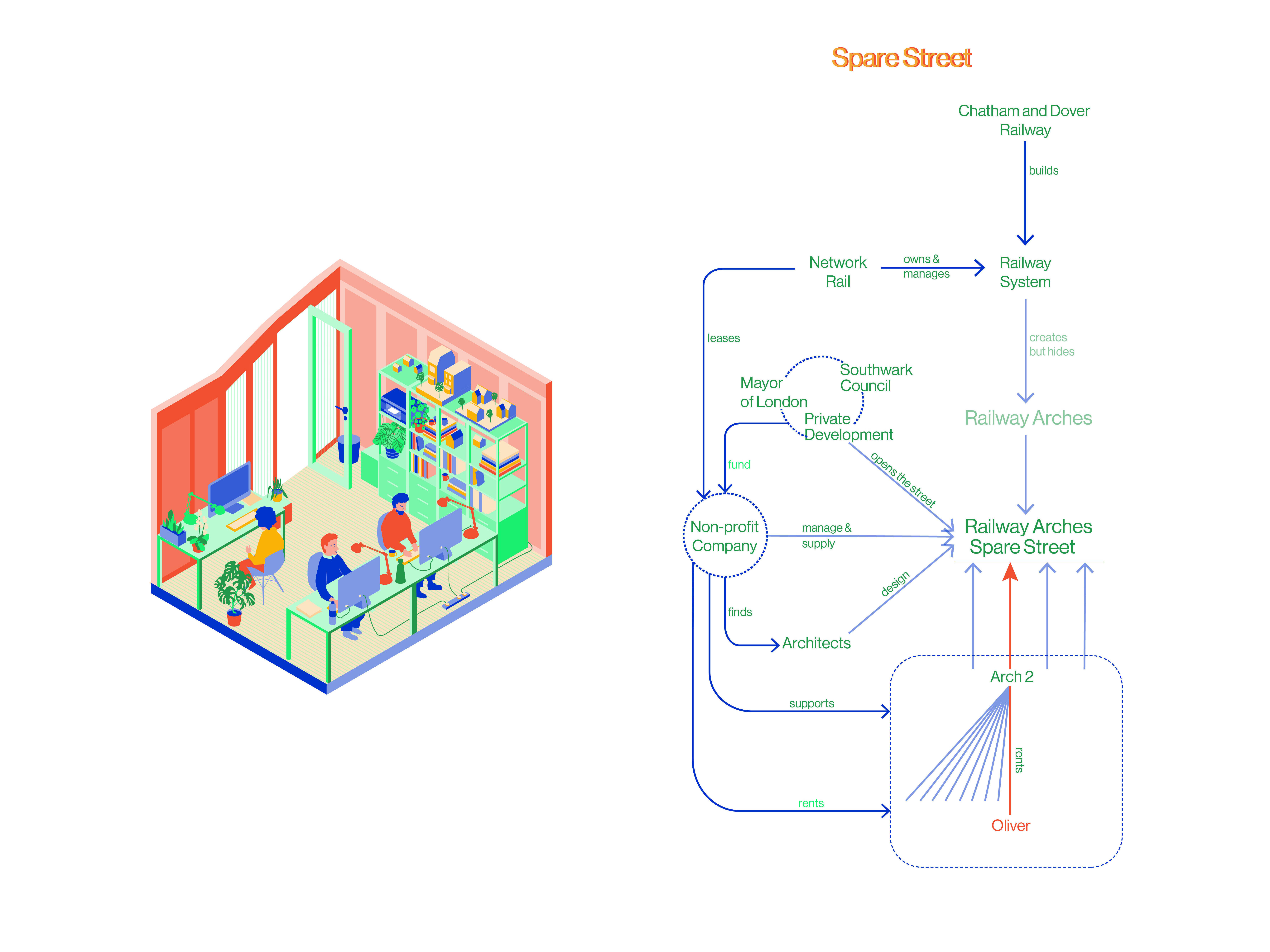This is part of Theatrum Mundi’s research project Urban Backstages, investigating the conditions of cultural production in Paris, Marseille, Glasgow, and London with support from the Ax:son Johnson Foundation. The research is conducted by John Bingham-Hall, Andrea Cetrulo, Cecily Chua, Elahe Karimnia, Fani Kostourou and Justinien Tribillon. The article was published in MONU#32 magazine on 20 April 2020. MONU is a unique English-language, biannual magazine on urbanism that focuses on the city in a broader sense. Issue 32 was about Affordable Urbanism.
In September 2018, Network Rail sells 5,261 UK railway arches to Telereal Trillium and Blackstone Property Partners for 1.46bn. Eight months later, the National Audit Office estimates that rents for these properties will increase by 54% over the next three to four years. The sale signals a threat to all the small businesses currently accommodated in the arches, and the artists, artisans, mechanics and craftsmen that rely on affordable centrally located workspaces especially in cities like London that rarely provide it.
Refuge
There are around 10,000 railway arches in London, used as studios, workshops, fabrication or repair shops, storages, taxi services, even factories and kitchens. 1 They host activities that can be constructively paired with what lies above despite their sub-standard, unfit for purpose, and non-designed physical conditions. Messy noisy trades, small industries, music and dance rehearsal spaces are relatively unaffected by the noise from the railways whilst benefiting from having no neighbours above or below to disturb. Whereas light restriction, thermal comfort and connection to city networks remain perennial problems; they allow the arches to become a refuge for less development friendly forms of production. They contribute to the shaping of culture in the city, operating from the backstage, behind front doors and in hidden locations under arches.
Grain
Although the arches’ combined volume is an enormous publicly-owned asset, due to their narrowly segmented plots and long configurational stretch they can be neither seen all-at-once nor fully controlled by a single entity. On the one hand, their lengthways division results in a fine-grained morphology that allows for greater socio-economic diversity. Although a disadvantage for developers looking to invest over bigger-sized plots, this formal quality guarantees that control lies in many hands. As Anne Vernez Moudon says: “many people make many different decisions, thereby ensuring variety in the resulting environment”. 2 On the other hand, the linear configuration of arches cuts through the urban fabric and benefits from the connectivity of a networked transport system.
Loopholes
The above characteristics encourage a number of ad hoc ingenious transformations in response to the needs of the tenants. One witnesses the addition of mezzanine floors, the modification of façades, or the internal subdivision of the arches, often without permission of local authorities or the landowner. Case point is that neither minor architectural interventions nor change of use class require a planning application due to their minimal impact on neighbours.This means that the functions of a brewery, an auto repair workshop and a dance studio can interchange at will, limbo dancing under the radar of regulations. An audio visual equipment supplier in one of the arches in South London says “we’ve probably changed the layout 8 times in the 8 years we’ve been here”, while other tenants further down the same street admit there is no control from the company or the council–“nobody ever checks”.
Limbo
The very same characteristics also protect the Inner London’s railway arches from developer-led regeneration processes and the gentrification that comes with it. For years the arches have been considered subsidiary spaces–by-products of the train network that traverses the country; so, they have remained unfashionable and undesirable spaces to invest and develop. Landlord Network Rail has been benignly neglecting them partly due to their sheer number, partly due to their supporting role to the railway. Craftswoman, Andrea, admits that “Network Rail, originally at least, when the artists had got them 16 years ago… just wanted to get rid of these spaces, they didn’t really care. Essentially the rail is what they did and the spaces underneath were just like an excess.” From the landlord’s perspective the railway tracks generate their own economic revenue, thus any income that comes from renting the arches below them is negligible. As a result Network Rail has been able to rent the arches out at low prices, offering affordable centrally-located spaces to a number of small businesses.
Conflicts
While the adverse effects of increasing rents are well known and researched in the field of housing, 3 this is not equally true for the culturally productive sites we are focusing on. As Theatrum Mundi’s research on Beck Road has already pointed out, affordability can influence the patterns and configurations of creative practices. 4 Rising prices can push people out, but they can also push them ‘in’ to smaller places that can be more economically efficient yet get easily crammed. They also affect the work produced in terms of the levels of inquisitiveness and experimentation it can afford. If renting studios costs a lot or entails a bureaucratic managerial process, creative and knowledge production can be stymied by control and accountability. Gradually, independent and unincorporated practitioners are forced out, replaced by what Richard Florida calls the ‘creative class’, young bohemian types and tech professionals who like funky, socially free areas with cool downtowns and lots of density. 5 In the absence of formal workplaces, practitioners withdraw in their domestic spaces, even beds, depriving themselves from the joys of working collaboratively. 6
Alice, operates a small independent fashion brand within one of the arches in South London’s Elephant and Castle, and runs a Chinese restaurant on the neighbouring high street. She has mixed feelings about the ongoing gentrification. “It’s kind of bittersweet just because it really benefits my restaurant, you know what I mean? Across there there’s obviously quite a lot of houses being built. They automatically become our customers. So our restaurant business has gone up quite a lot, but also the rent has gone up, so it kind of levels itself out.” She also notices the conflicts between who gets a space and why. “so the developers across the road, who are doing Elephant Park, came to us and offered us a space, which was obviously too much for us to move. But a lot of the businesses in there, they just weren’t offered space because I think the developers were quite snobby about who they wanted to put in there. They’re not going to put in a Latin American market–which is a shame. And then you just wonder where all those businesses are going to go.”

Elephant and Castle
In the minds of the majority, Elephant and Castle mainly functions as a major transport hub; the result of its strategic location (Figure 1). It is also considered, mainly by politicians “a place of environmental degradation and poverty, stigmatised through a discourse of ‘ugliness’”; 7 an aftermath of its regeneration in the 1960s. Yet, it has historically been a key commercial and cultural spot in the city, dubbed in the early twentieth century as the ‘Picadilly of the South’. Over the decades, the council’s neglect of the shopping centre at the heart of Elephant and Castle has resulted in its degradation and appropriation by London’s thriving Latin American community. 8 Today, the wider area faces a massive controversial regeneration programme initiated by the local authority. In the last ten years, Southwark Council has sold publicly-held land to developers such as Lendlease and Delancey to push forward a £3bn privately-funded regeneration plan that proposes—among other things—the replacement of the shopping centre with a new town centre, the provision of new housing, and the commercialisation of the railway arches. 9 However, this renders the future of arches uncertain. Oliver Wainwright posits that “Everybody might love to belong in Australian developer Lend Lease’s gilded vision for the area, but few will be able to afford it”. 10
Resistance
Viviana, Alice, Isaac, and Oliver are four of hundreds of the artists, artisans, mechanics and craftsmen working in the railway arches of Elephant and Castle. The benign negligence of the landowner, developers, and planning systems has allowed their and others’ businesses to proliferate within the same spatial typology and neighbourhood, feeding its socio-economic diversity and vitality. By amplifying the voices of these individuals, four acts of resistance are presented as counter strategies to top-down planning policies and neoliberal market forces encroaching on their workspaces. These acts are essentially alternative practices through which individuals make and maintain their own infrastructures whether financial, physical, organisational or emotional to continue their productive existence in the city. Similar to Saskia Sassen, resistance is understood here as the enhanced potential of individuals to ‘talk back’ to the interactive deployment of agendas, businesses, infrastructures, projects and imaginaries over a confined terrain. 11

Community
“This place acts as a social hub, not only a restaurant. When a new migrant arrives with just a suitcase and nowhere to go, we provide them with food and shelter. This pays back as they always return once their situation gets better.” Viviana and her husband, who plays in the local Colombian football team, run a cafe in a necklace of Latin American businesses threaded along Maldonado Walk (Figure 2). The Latin community supports the ethnic entrepreneurs’ integration and recognition in London’s diverse economy and space by facilitating and encouraging links between their initiatives. As part of an active community of Latin migrants, Viviana and her husband can resist the rapid regeneration process through a network of mutual support (Figure 3).
Digital
For Alice, who runs the fashion brand and Chinese restaurant, different functions exist side by side activating the arches 24/7: “after my parents retired, me and my sister, we took over that restaurant. So we do that in the night-time and I do my business in the daytime.” Alice has developed resistance against the imminent physical regeneration by going digital, adjusting the ways she produces clothing and her business operates. Unlike other lifestyle and womenswear businesses, her studio does not acquire any visibility or physical relation to the public street to attract customers. She advertises through social media; “basically, my Facebook, we’ve got about 23,000 followers. So that’s our main kind of income stream. We have a website as well. So we spend a lot of money on, like, internet marketing. Because that’s the only way really.” This liberates the creative practice from any spatio-temporal indication or location. “I split my time between so many things, I like that I don’t have to be at a certain place at a certain time. I think if it was open, people would kind of expect us to be there.” Nonetheless, there is a limit to how much urban infrastructure one can do without. For a digital business to run, it depends on highly contextual amenities such as high-speed broadband coverage and connection and a nearby post office depot for materials and logistics. An area like Elephant and Castle can definitely uphold that end of the deal.
Flexibility
Just a few arches away, Isaac runs an audio visual company that supports some of the cities most celebrated cultural institutions. His resistance derives from the continuous adaptation of his business’ mode of operation in a series of unwieldy arches in Robert Dashwood Way; a trade-off for their central location. “I built my business on the fact that I’m so close to the city […] We tailor what we do to the space we’ve got, because it’s more valuable to be here than it is to try and move somewhere bigger but further out of town.”
As previously suggested, negligence allows for spatial adaptations to occur in the interior of arches. Isaac admits that the arch-like form of the space does not suit the type of work they do as an event and logistics support company (Figure 4). For example, “if you have a client, and you’ve got a lot of gear for a client, you can create a sort of cage and put everything down in one place. Well, you can’t do that here because the ceiling prevents you from doing that.[…]so we have to work around it.”

Incorporation
Oliver’s resistance comes from a different perspective. “I’m getting to the stage where you want to be a part of a commercial community.” Oliver is an architect, sharing an office on a not-for-profit company that provides space for Arts, Culture and Enterprise in Spare Street (Figure 5). Together with his partners, they claim their agency as cultural producers by integrating their practice into a creative co-working space supported by formalised organisational, legal, and physical infrastructures. They understand that “to some extent, it’s an overhead that you don’t really want to take on […] it’s kind of like a commercial status to having your workspace.” But there is a limit to how much one can do on their own in isolation and reclusion. Oliver recounts that the three were working from home “for about 18 months, working from a kitchen table, and that was great, but I mean in terms of bringing in clients, it’s not exactly appropriate to be at the dining room table.” His reaction comes from a capability to feel out the changing urban and professional landscape and choose to incorporate into more patronaged structures of creative work (Figure 6).

2028
In September 2022, the sale is completed. The businesses of Viviana, Alice and Isaac have been relocated or forced to close. Their long-held networks and clienteles have been disrupted and their everyday routines have been lost. As their contribution to the shaping of London’s culture was based on purely economic terms, they were priced out. Retrospectively, the privatisation of railway arches overlooked the complex networks of infrastructures these people had built and worked to maintain over time. Ten years later we look back and wonder how these activities could have been protected. Perhaps we could have looked beyond the obvious, at the underlying conditions that have enabled such businesses to operate and thrive backstage. Perhaps we could have discovered ways to appreciate —if not measure—their contribution to the urban, political and cultural realm of cities. And perhaps we could have used this knowledge to reconsider new approaches to planning for culture in our cities.
All persons pseudonymised disclaimer:
The characters and incidents portrayed in this story are real, yet their names are fictitious. No identification with actual persons (living or deceased), places, buildings, and products can be inferred. No person or entity associated with this story received payment or anything of value. No animals or other non-human life was harmed in the making of this story.
Notes
- Froy, Francesca, and Howard Davis. ‘Pragmatic urbanism: London’s railway arches and small-scale enterprise.’ European Planning Studies 25, no. 11 (2017): 2076-2096.
- Moudon, Anne Vernez. Built for change: neighborhood architecture in San Francisco. Cambridge MA: MIT Press, 1986:188
- See for example Glass, Ruth Lazarus. London: aspects of change. Vol. 3. MacGibbon & Kee, 1964; Tribillon, Justinien. ‘London is the place for me’. In City of Comings and Goings, edited by Annuska Pronkhorst, 58-109. Rotterdam: nai010 Publishers, 2019; Campkin, Ben. Remaking London: Decline and Regeneration in Urban Culture. Vol. 19. IB Tauris, 2013.
- Bingham-Hall, John, Cecily Chua, Andrea Cetrulo, and Jayden Ali. ‘Urban Backstages: Unincorporated Artists Unite’, Theatrum Mundi, December 2019.
- Florida, Richard. The rise of the creative class. New York: Basic books, 2002.
- See for example Holliss, Frances. Beyond Live/Work: The architecture of home-based work. Routledge, 2015;Colomina, Beatriz, Andreas Rumpfhuber, and August Ruhs. The Century of the Bed. Verlag für moderne Kunst, 2014.
- Campkin, Ben. Remaking London: Decline and Regeneration in Urban Culture. Vol. 19. IB Tauris, 2013:16.
- King, Julia, Suzanne Hall, Patria Román-Velázquez, Alejandro Fernandez, Josh Mallins, Santiago Peluffo-Soneyra, and Natalia Perez. ‘Socio-Economic Value at the Elephant & Castle’. London, UK: London School of Economics and Political Science, Department of Sociology, 2018.
- https://www.elephantandcastle.org.uk
- Wainwright, Oliver. ‘Revealed: how developers exploit flawed planning system to minimise affordable housing’. The Guardian, June 2015.
- Sassen, Saskia. ‘Does the city have speech?.’ Public Culture 25, no. 2 70 (2013): 209-221.